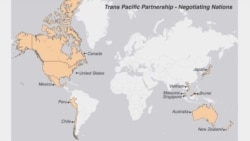“Nations across the [Asia-Pacific] region face choices,” U.S. Assistant Secretary of State for East Asian and Pacific Affairs Daniel Russel said recently in Seattle, Washington, to promote the Trans-Pacific Partnership agreement. “Are they going to move toward greater political freedom and respect for universal rights and values? Are they going to open their economies while protecting workers, investors, and the environment? Are they going to strengthen the international and regional system of rule of law to treat all countries fairly? And by doing that, avoid conflict that could lead to loss of life and crippling economic consequences for all of us?”
It is a critical time for the Trans-Pacific Partnership agreement, or TPP.
“We can’t take the answers to any of these questions for granted, and they’re all interconnected,” said Mr. Russel.
TPP negotiators are now working around the clock, and countries are moving on issues that seemed intractable months ago.
“We need TPP to promote economic growth and support higher-paying jobs [across the region],” U.S. Assistant Secretary Russel said. “TPP is important to long-time partners with whom we already have Free Trade Agreements. It’s important to new partners like Vietnam and Malaysia as they seek to further reform and develop their economies. And it’s important to Japan as [it] works on structural reforms.”
The Trans-Pacific Partnership gives its 12 members an opportunity to protect workers and the environment with the highest and most enforceable standards of any trade agreement ever – allowing us to tackle anumber of issues that have never been addressed before in trade pacts.
“We see TPP as the best pathway to a larger Free Trade Area of the Asia-Pacific,” Mr. Russel said.“But in the meantime, we’re continuing to move forward with partners outside the TPP. The biggest, of course, is China.”
“Our diplomacy with China has allowed us to expand the areas where we work together, while managing our clear differences,” he continued. “And that diplomacy over many years, including bringing China into the World Trade Organization, has supported China’s economic rise, enabling trade and increased exports to China.”
With the Trans-Pacific Partnership in place, Assistant Secretary Russel said, “the U.S. and Asia will continue to grow and prosper together.”
















